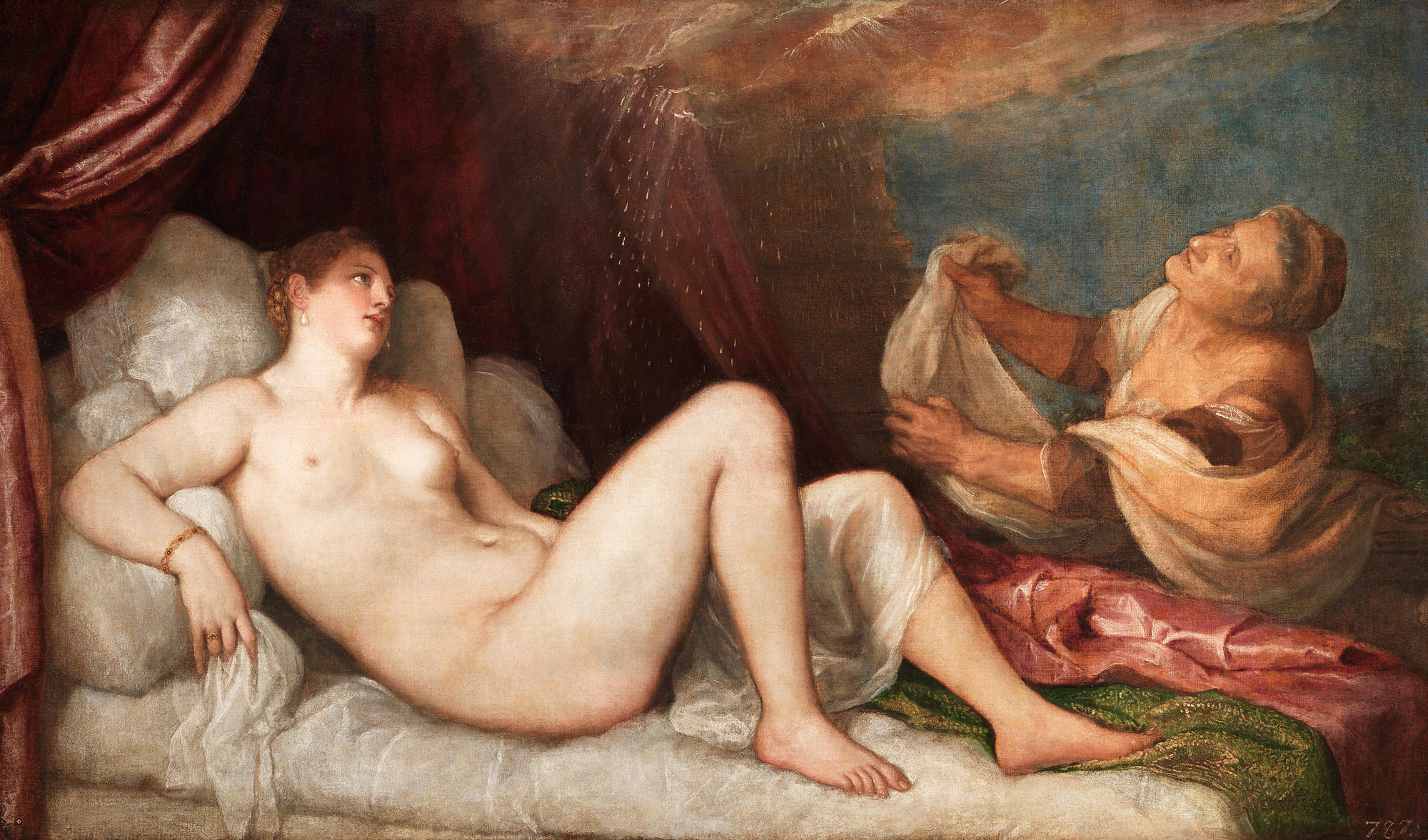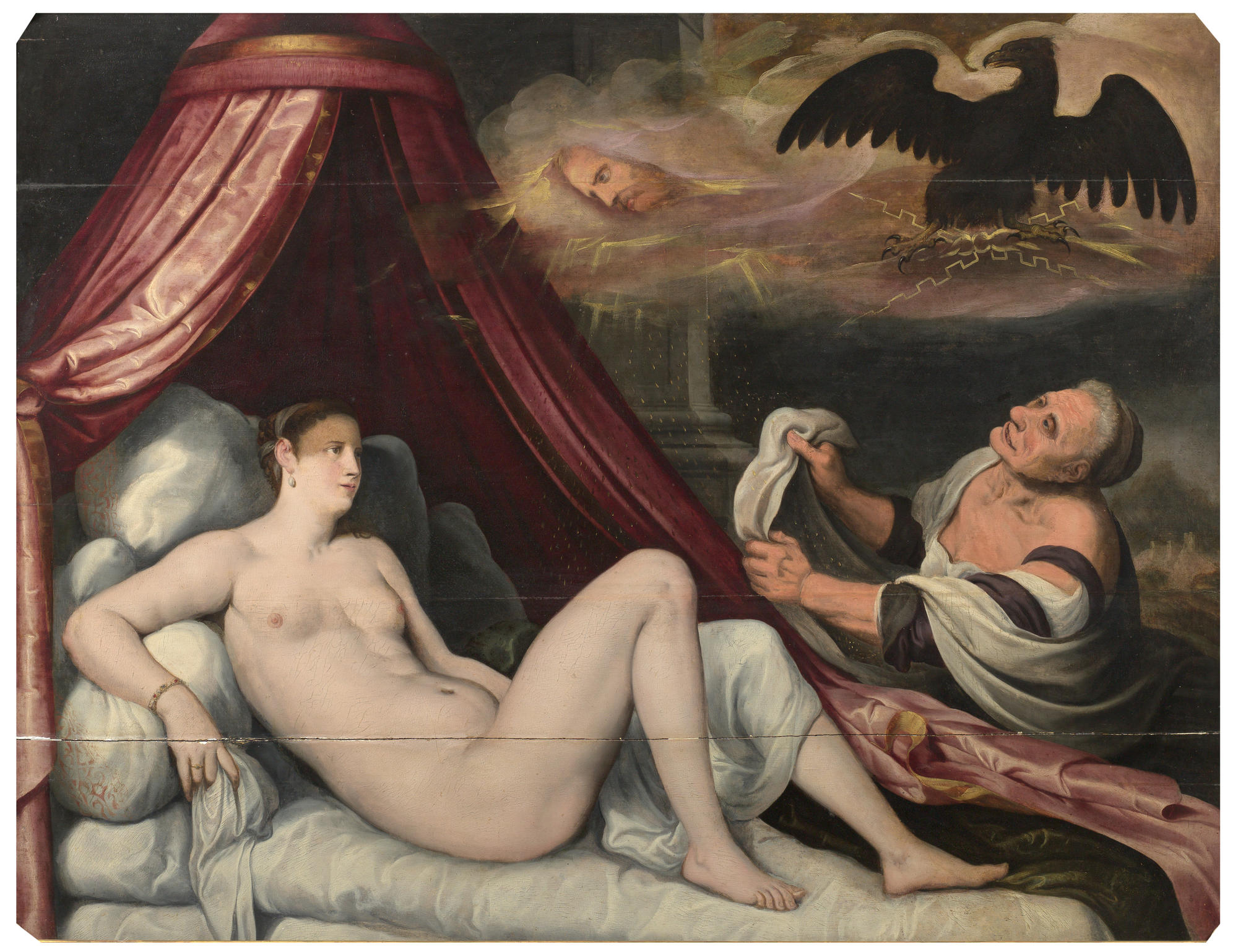Danaë

Titian (Italian, about 1488–1576), Danaë, 1551–1553. Oil on canvas, 187 x 204.5 cm (73 5/8 x 80 1/2 in.)
The Wellington Collection, Apsley House, London
OBJECT DESCRIPTION
At the center of this horizontal rectangle oil painting is a light-skinned nude woman reclining on an off-white-colored bed. The title of this painting identifies her as Danae. She lays on her back across the length of the bed, supported by many pillows and facing our right. Her arm closest to us rests on a pillow, and she wears a thin gold bracelet on that wrist. There is a gold ring on her hand which holds a white, transparent piece of cloth. Her knees are bent and her leg furthest from us is covered in the same transparent, white cloth. She has short light brown hair, wears white dangling earrings, and has a dreamy look on her face as she gazes upward. To our right is a medium-skinned female. This older looking woman is dressed in a brown dress with a peach and white shawl about her shoulders. She holds the ends of the shawl in both of her outstretched hands as she, too, gazes upward at a multi-colored cloud. Shining drops of gold water fall from this cloud. A drape made of pink and red fabric falls on each side of Danae’s bed. The end of this curtain and dark green fabric with golden tones are draped across the foot of her bed.
OBJECT COMMENTARY
Nearly nude and richly bejeweled, the young princess Danaë reclines on her bed. Jupiter—king of the gods —approaches from the cloud above. Fearing a prophecy that predicted his death at the hands of his grandson, Danaë’s father had locked her in a tower, and Jupiter has transformed himself into a shower of gold to penetrate its walls and seduce the transfixed princess.
Titian reimagined the girl’s servant. Instead of an aged maid, she becomes the troubling facilitator of this sexual encounter. The old woman’s leathery skin, weathered features, and burst of motion contrasts with Danaë’s shapely figure, frontal nudity, and languid pose—all further fetishizing her body as the object of Jupiter’s lust.
A part of this painting is missing. At a later date, the upper third of the canvas was removed, eliminating Jupiter’s face and Philip’s emblems. A copy (fig. 1) reveals the lost compositional features.

Fig 1: Netherlandish School, Danaë, late 16th century. Oil on panel, 157.5 x 194.4 cm.
Museo Nacional del Prado, Madrid. © Photographic Archive Museo Nacional del Prado
Reconsidering Titian Today
It's such an incredible representation of the humanity of the body, of the fleshiness of the body, which is so important for these stories about mythology . .
Steve Locke (b. 1963, Cleveland, OH) is a Boston-based artist, raised in Detroit, Michigan. He received an M.F.A. in 2001 from the Massachusetts College of Art and Design and holds Bachelors Degrees from Boston University and MassArt. He attended the Skowhegan School of Painting & Sculpture in 2002. He has been an Artist-in-Residence at the Isabella Stewart Gardner Museum in Boston (2016) and for the City of Boston (2018). He has received grants from The Pollock-Krasner Foundation, The Louis Comfort Tiffany Foundation, and The Art Matters Foundation. Solo exhibitions include, there is no one left to blame, curated by Helen Molesworth for the Institute of Contemporary Art, Boston, The School of Love with Samsøñ (Boston, MA), Family Pictures with Gallery Kayafas (Boston, MA and most recently #Killers at YOURS MINE & OURS in New York. He has had solo projects with the Boston Public Library, the Isabella Stewart Gardner Museum, Mendes Wood in Sao Paulo, Brazil, at VOLTA 5 in Basel, Switzerland and P.S. Satellites-A Project of Prospect IV in New Orleans. His work has been reviewed in ARTFORUM, Art in America, Art New England, JUXTAPOZ, The Boston Globe, and The New Yorker. He joined the faculty at Pratt Institute in New York in the Fall of 2019.
The lead sponsors of Titian: Women, Myth & Power are Amy and David Abrams and The Richard C. von Hess Foundation
The presenting corporate sponsor is:

This exhibition is supported by the Robert Lehman Foundation, Fredericka and Howard Stevenson, and an indemnity from the Federal Council on the Arts and the Humanities. Additional support is provided by an endowment grant from The Andrew W. Mellon Foundation and the National Endowment for the Humanities. The Museum receives operating support from the Massachusetts Cultural Council. Media Sponsor: The Boston Globe.







